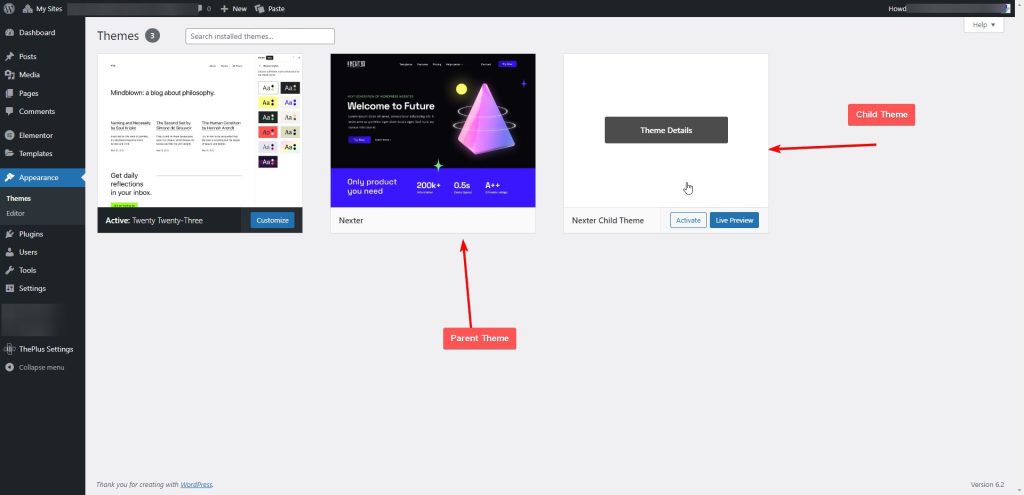As a WordPress user, I have often come across the terms “child theme” and “Default theme,” but I didn’t quite understand the difference between the two.
After doing some research, I realized that the difference between a child theme and a normal WordPress parent theme is significant, and it can impact the way your website looks and functions.
Table of Contents
WordPress Child Theme vs Default Theme: Which One You Should Choose?
Takes dive in depth in these terms meaning & benefits

What are WordPress Child Themes?
A child theme is a theme that inherits the functionality, features, and style of another WordPress theme, the parent theme. With a child theme, you can customize the look and feel of your website without making any changes to the parent theme. Creating a child theme is as simple as creating a new folder containing two files, style.css and functions.php.
What are Default Parent WordPress Theme ?
A parent theme is a complete, stand-alone WordPress theme that can be used to create a website. It is a theme that is fully functional on its own without the need for any other features from any other theme.
Dependency between Child and Parent WordPress Themes
A child theme cannot function on its own without the parent theme. The child theme inherits the functionality of the parent theme. The child theme can be used to make modifications to any part of the parent theme. In this way, customizations are kept separate from the parent theme’s files.
Wondering if you should create a WordPress Child Theme Manually or using a Plugin? Check this blog where I have shared this in details.
Why Create a WordPress Child Theme?
I always recommend creating a child theme when customizing a WordPress theme.
And here are a few reasons why:
- Ease of Customization – Creating a child theme allows you to make customizations to your WordPress website without affecting the parent theme. This means that you can update your parent theme without losing any of your customizations. Additionally, you can easily undo any changes made to your child theme by simply deactivating it.
- Safe Updates – When you modify the files of a parent theme, you run the risk of losing your modifications when the theme is updated. Creating a child theme ensures that your customizations are safe from updates. You can update your parent theme without worrying about losing your customizations.
- Template and Style Modifications – A child theme allows you to modify the template files and style.css file of the parent theme. This means that you can modify the structure and styling of your website without affecting the core functionality of the parent theme.
Are you Spending hours:
- Managing your WordPress website?
- Troubleshooting Technical difficulties?
- Dealing with plugin Security Issues?
- Website Uptime Monitoring?
- Cleaning Hacked Sites?
Let me take care of your WordPress website, so you can focus on scaling your agency.
Give your clients top-notch VPS Hosting for blazing fast performance, 24×7 security monitoring with autopilot safe plugin updates.
I will help you free up time by managing WordPress websites.
Disadvantages of using Child Themes
One of the disadvantages of using a child theme is that it can be difficult to maintain. If the parent theme is updated, you will need to update the child theme as well. Failure to do so can lead to compatibility issues and can cause your website to break.
Another disadvantage of using a child theme is that it can be time-consuming to create. You will need to create the child theme files and then make modifications to the code to create the desired look and feel.
Differences Between Child and Parent Themes
Let’s skim through quick differences between these two in tabular format
| Child Theme | Parent Theme |
|---|---|
| Inherits functionality and styling from parent theme | Standalone theme that provides all necessary functionality and styling |
| Allows modifications and customizations without directly editing parent theme files | Requires direct editing of theme files for modifications and customizations |
| Can be updated without losing customizations | May require redoing customizations after an update |
| Can override parent theme templates and functions | Cannot be overridden by child theme |
| Typically smaller and simpler than parent theme | Typically larger and more complex than child theme |
| Designed to work with specific parent theme | Can work with any WordPress installation |
| Requires parent theme to be installed and activated | Can be used without child theme |
| Good for making customizations and tweaks to existing theme | Good for creating a new theme from scratch |
Conclusion: Which One Should you Choose?
In conclusion, understanding the difference between a child theme and a parent theme is crucial for website developers and users alike.
Overall, whether to use a child theme or a parent theme depends on the specific needs and goals of the website and its users. Developers may prefer to use a child theme for customization purposes, while users may prefer the simplicity and ease of a parent theme. Additionally, theme frameworks can also be a useful tool for creating and managing child themes.
In any case, understanding the difference between child and parent themes is essential for making informed decisions about website design and development.
I share my Learnings & Case studies via email.
Subscribe to Stay Updated
Frequently Asked Questions
What is the purpose of a child theme in WordPress?
The purpose of a child theme in WordPress is to allow you to make modifications and customizations to a parent theme without directly editing its files. This is useful for preserving your changes when the parent theme is updated, and for creating a theme that is tailored to your specific needs.
Can a child theme be used without a parent theme in WordPress?
No, a child theme cannot be used without a parent theme in WordPress. A child theme is designed to inherit the functionality and styling of a parent theme, so it requires a parent theme to work properly.
What happens if a parent theme is updated in WordPress?
If a parent theme is updated in WordPress, any modifications or customizations made to the parent theme will be lost. However, if you are using a child theme, your modifications and customizations will be preserved, as long as they are made in the child theme files.
Can a child theme override a parent theme’s templates and functions in WordPress?
Yes, a child theme can override a parent theme’s templates and functions in WordPress. This allows you to make more extensive modifications to the parent theme without directly editing its files.
